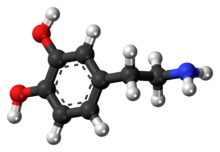3,4-dihydroxyphenethylamine
 |
|
 |
|
| Clinical data | |
|---|---|
| Synonyms |
|
| Physiological data | |
| Source tissues | Substantia nigra; ventral tegmental area; many others |
| Target tissues | System-wide |
| Receptors | D1, D2, D3, D4, D5, TAAR1 |
| Agonists | Direct: apomorphine, bromocriptine Indirect: cocaine, amphetamine |
| Antagonists | Neuroleptics, , domperidone |
| Precursor | Phenylalanine, tyrosine, and L-DOPA |
| Biosynthesis | DOPA decarboxylase |
| Metabolism | MAO, COMT |
| Identifiers | |
|
|
| CAS Number | |
| PubChem CID | |
| IUPHAR/BPS | |
| DrugBank | |
| ChemSpider | |
| KEGG | |
| ECHA InfoCard | 100.000.101 |
| Chemical and physical data | |
| Formula | C8H11NO2 |
| Molar mass | 153.18 g·mol−1 |
| 3D model (JSmol) | |
|
|
|
|
Dopamine (DA, a contraction of 3,4-dihydroxyphenethylamine) is an organic chemical of the catecholamine and phenethylamine families that plays several important roles in the brain and body. It is an amine synthesized by removing a carboxyl group from a molecule of its precursor chemical L-DOPA, which is synthesized in the brain and kidneys. Dopamine is also synthesized in plants and most animals. In the brain, dopamine functions as a neurotransmitter—a chemical released by neurons (nerve cells) to send signals to other nerve cells. The brain includes several distinct dopamine pathways, one of which plays a major role in the motivational component of reward-motivated behavior. The anticipation of most types of rewards increase the level of dopamine in the brain, and many addictive drugs increase dopamine neuronal activity. Other brain dopamine pathways are involved in motor control and in controlling the release of various hormones. These pathways and cell groups form a dopamine system which is neuromodulatory.
In popular culture and media dopamine is often seen as the main chemical of pleasure, but the current opinion in pharmacology is that dopamine instead mediates incentive salience which signals the value of a given reward to the organism and motivating action required for attainment. In other words, dopamine appears to mediate desire and motivation moreso than pleasure.
Outside the central nervous system, dopamine functions primarily as a local chemical messenger. In blood vessels, it inhibits norepinephrine release and acts as a vasodilator (at normal concentrations); in the kidneys, it increases sodium excretion and urine output; in the pancreas, it reduces insulin production; in the digestive system, it reduces gastrointestinal motility and protects intestinal mucosa; and in the immune system, it reduces the activity of lymphocytes. With the exception of the blood vessels, dopamine in each of these peripheral systems is synthesized locally and exerts its effects near the cells that release it.
...
Wikipedia
